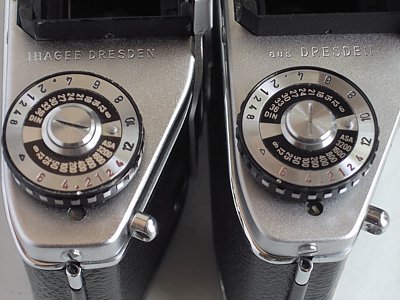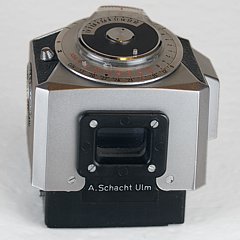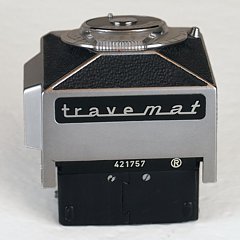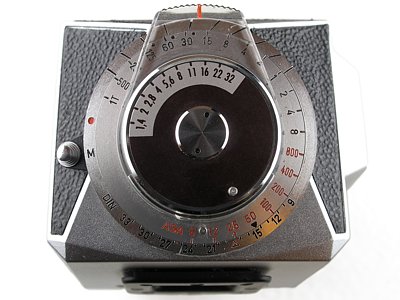I'm not collecting cameras just to boast "one of each", but rather to learn about the evolution in technology, about history, and about the human nature itself. I also try to know as much as possible about the previous owner of each camera I own. And this camera, indeed, is interesting from all these angles.
Let me address the personal story before going technical.
-1205972-fr.jpg)
Exakta VX 1000 *7.0.t (A&R v1.2) #1205972, 1969-70
Lens: 2.50/50 Zeiss ("aus Jena") Pancolar #8452598 (1969)
Finder: Schacht Travemat metering prism (1967, #421757)
A letter
One June day of 2004, I received an unexpected parcel in mail. The sender's name seemed familiar, but I couldn't exactly say why. Inside was a camera: a nice, clean Exakta TL VX 1000 and a letter, which I find interesting enough to share with you (with minor edits as marked).
Dear Mr. Wrotniak,
Some months ago I was in E-mail correspondence with you concerning the enclosed Exakta camera; you aided me in identifying it. (...)
It was the property of Fr. Josef Mitros, S.J., A Polish Jesuit who survived five war-time years in a concentration camp, emigrated (...) to the United States and found a teaching position at Fordham, where until his retirement he taught dogmatic theology (he had doctorates in theology and philosophy from the University of Lublin).
He died a year and a half ago at the age of 91; the camera was among his effect. No one in the Jesuit community having found any use for it, it ended up without a claimant, clamans domino, as one said in law school long ago when Latin still had its uses. I rescued it from this ignominy. While I have neither the time nor the talent to explore its virtues, I did not wish to see it discarded as valueless; it is at least worth cannibalizing for parts.
I send it to you as simply because you appreciate fine cameras (...) without strings, simply as a gift in the hope that you may find some use for it. You have a fine web site from which you will long since have learned that no good deed goes unpunished.
Cordially,
[Name withheld - JAW]
Emeritus Professor of Theology
Here the story made a full circle: Father Josef (or, in Polish, Józef) attended the Catholic University of Lublin, abut 30 miles from where both my parents were born, before he settled down in Bronx, NY. Small world.
The camera will go into a dignified retirement (which each Exakta deserves) in my collection, together with the accompanying note, as soon as I bring it back from my next trip to Poland, where I'll have it cleaned, adjusted, and lubricated so that it remains usable for the next 50 years or so (yes, Exaktas live this long!).
The camera
This Exakta is a fairly common VX 1000 model from about 1970, the last top-of-the-line model made by Ihagee in Dresden, East Germany. If not the most collectible of Exaktas (more than 100,000 of this model were made), it is one of those most usable for taking pictures, even now.
This particular cosmetic variant, however, is a little less common. It is distinguished with letters "TL" on the front plate, denoting through-the-lens metering.
Now, Exakta bodies never had this feature, already quite common in the Japanese competition. To fight obsolescence, Ihagee reached an agreement with the West German firm of A. Schacht, who provided TTL-metering Travemat prisms; these were often sold bundled with Exaktas sold to the U.S. and Western Europe markets, and marked with the "TL" symbol. In the late Sixties Harwix of Berlin was also making a similar prism, also shown in Ihagee's Exakta accessory list, although I'm not sure if it was distributed with Exakta bodies.
The camera itself was also in good shape: clean mirror, nice exterior, functional shutter — and even long shutter times working OK. A really nice surprise.
The VX 1000 was manufactured from 1967 to 1970. This particular one seems to be from the last year of production, not only because of a late serial number (see my Exakta Taxonomy, but also because the Ihagee maker name is nowhere shown.
Another interesting detail can be spotted on camera's top plate. While earlier cosmetic variants (see the *7.0.x, shown here at left) had Ihagee Dresden engraved next to the finder, the TL VX 1000 (*7.0.t, at right), made in 1969 or 1970, has just aus Dresden.
The reasons were purely legal. After the Ihagee company was "nationalized", the rightful owners reclaimed the rights to the name (1960), and ultimately East Germany had to stop using Ihagee if they wanted to sell their cameras to the West.
This was an act of justice on one hand (as the "nationalization" was nothing short of institutionalized robbery), but a sad end of a proud Dresden tradition on the other.

(In the previous picture you may also notice that the standard Pancolar lens is marked as aus Jena instead of using the prestigious Carl Zeiss name, for similar reasons.)
In the late Sixties, TTL metering was quickly becoming a standard in better SLR cameras. Most Japanese models had it already, and even some East-German ones (like the popular Practica LLC) did. But not Exakta (although Ihagee had a prism with a non-TTL, uncoupled selenium meter largely ignored by the market).
The gap was filled by two companies.
- In 1966 A Schacht from Ulm, West Germany, introduced a TTL metering prism named Travemat, which stayed in production at least until 1970 in three slightly different versions.
- In 1968 Harwix of West Berlin started making a similar device under the name of Examat. (According to Hummel, the design was by Ihagee.)
Because of the hard-currency origin of the Travemat and Examat prisms, they were never available in Communist-dominated countries; a common policy was to pay the "real money" for parts or components only if the final product was later sold for hard currency.
This may be a reason why I didn't have a Travemat or Examat unit in my collection until now. Those found of eBay are usually non-functional, and I didn't bother buying something obviously broken. To my delight I discovered that Father Josef's meter seems operational.
Both prisms used a CdS (cadmium sulfide) photoresistor overlooking the finder groundglass. By measuring the current caused by a constant battery voltage, they were effectively metering the light reaching the image plane (the groundglass is the image plane); the most reliable and accurate way of doing it.
As the Exakta lens mount was missing any aperture coupling to the camera body, the metering was done by stepping the aperture down until the meter needle matched the mark in the finder. Full-aperture metering was also possible, but it required a manual transfer of the metered value to the aperture ring. As inconvenient as the process may seem today, its introduction was, indeed, a major step ahead.
The Travemat, in spite of its 1966 vintage, would work with any Exakta bodies starting from the VX of the 1950; the TL marking on the camera body was just marketing.



